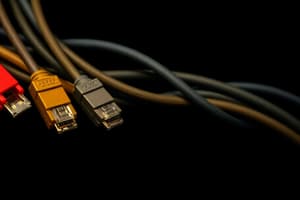Podcast
Questions and Answers
Unshielded Twisted Pair (UTP) cables offer better protection against electromagnetic interference than Shielded Twisted Pair (STP) cables.
Unshielded Twisted Pair (UTP) cables offer better protection against electromagnetic interference than Shielded Twisted Pair (STP) cables.
False (B)
Twisted-pair cables are primarily used in local area networks (LANs).
Twisted-pair cables are primarily used in local area networks (LANs).
True (A)
Twisted-pair cables cannot be used for audio/video transmission.
Twisted-pair cables cannot be used for audio/video transmission.
False (B)
Cat 8 twisted-pair cables support speeds up to 25-40 Gbps with a bandwidth of up to 2000 MHz.
Cat 8 twisted-pair cables support speeds up to 25-40 Gbps with a bandwidth of up to 2000 MHz.
Proper twisting and untwisting limits are not important for maintaining the performance of twisted-pair cables.
Proper twisting and untwisting limits are not important for maintaining the performance of twisted-pair cables.
Flashcards are hidden until you start studying
Study Notes
Twisted-Pair Cables
-
Definition: Twisted-pair cables consist of pairs of copper wires twisted together, which helps to reduce electromagnetic interference (EMI).
-
Types:
- Unshielded Twisted Pair (UTP):
- Commonly used in Ethernet networks.
- No additional shielding; lightweight and cost-effective.
- Categories range from Cat 1 to Cat 8, offering different bandwidths and transmission speeds.
- Shielded Twisted Pair (STP):
- Contains a foil shield around the pairs to provide additional protection against EMI.
- Heavier and more expensive than UTP.
- Used in environments with high interference.
- Unshielded Twisted Pair (UTP):
-
Categories:
- Cat 5e: Supports speeds up to 1 Gbps and bandwidth up to 100 MHz.
- Cat 6: Supports speeds up to 10 Gbps and bandwidth up to 250 MHz.
- Cat 6a: Enhanced version of Cat 6, supports 10 Gbps at longer distances (up to 100 meters).
- Cat 7: Supports speeds up to 10 Gbps; improved shielding to reduce crosstalk.
- Cat 8: Designed for data centers, supports up to 25-40 Gbps with a bandwidth of up to 2000 MHz.
-
Advantages:
- Cost-effective for network installations.
- Flexibility in installation due to lightweight and low bulk.
- Sufficient for most residential and office network applications.
-
Disadvantages:
- Limited distance for high-speed transmission (typically 100 meters for most categories).
- Susceptibility to interference in environments with heavy electrical equipment (more so in UTP).
-
Applications:
- Primarily used in local area networks (LANs).
- Telecommunication, telephone lines, and audio/video transmission.
- Widely used for Ethernet connectivity in homes and businesses.
-
Installation Considerations:
- Proper twisting and untwisting limits are critical to maintain performance.
- Utilize appropriate connectors (RJ45 is standard for Ethernet).
- Avoid running cables near high-voltage power lines to minimize interference.
Twisted-Pair Cables
- Twisted-pair cables comprise copper wire pairs that are twisted together to mitigate electromagnetic interference (EMI).
- Unshielded Twisted Pair (UTP)
- Popular in Ethernet networks.
- Lightweight and budget-friendly; lacks extra shielding.
- Categories (Cat 1 - Cat 8) provide varying bandwidths and speeds.
- Shielded Twisted Pair (STP)
- Foil shielding encases wire pairs for enhanced EMI protection.
- Heavier and costlier than UTP.
- Employed in high interference environments.
- Categories
- Cat 5e: Up to 1 Gbps, 100 MHz.
- Cat 6: Up to 10 Gbps, 250 MHz.
- Cat 6a: Enhanced Cat 6; 10 Gbps up to 100 meters.
- Cat 7: Up to 10 Gbps; improved shielding to reduce crosstalk.
- Cat 8: Data centers, 25-40 Gbps, 2000 MHz.
- Advantages
- Economical for network installations.
- Lightweight and compact, allowing flexibility in installation.
- Suitable for most home and office networks.
- Disadvantages
- Limited high-speed transmission distance (typically 100 meters).
- UTP more prone to interference from heavy electrical equipment.
- Applications
- Predominant use in Local Area Networks (LANs).
- Telecommunications, telephone lines, audio/video transmission.
- Extensive use in Ethernet connections for homes and businesses.
- Installation Considerations
- Precise twisting and untwisting limits are crucial for performance.
- Utilize appropriate connectors (RJ45 for Ethernet).
- Avoid routing cables near high-voltage lines to minimize interference.
Studying That Suits You
Use AI to generate personalized quizzes and flashcards to suit your learning preferences.




